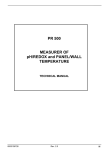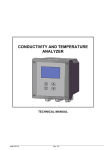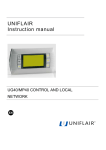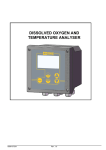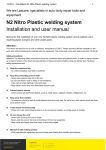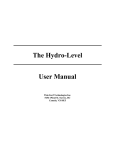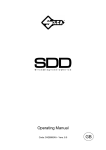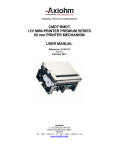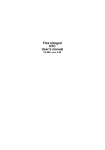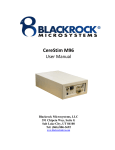Download CD 500 - Sispa
Transcript
CD 500 CONDUCTIVITY and TEMPERATURE PANEL/WALL ANALYSER INSTRUCTIONS MANUAL . 0000136727 Rev. 2.0 III INDEX 1 GENERAL ............................................................................................................................................................... 1 1.1 INFORMATION ON THE MANUAL ............................................................................................................. 1 1.1.1 CONVENTIONS ........................................................................................................................................ 1 1.2 DECLARATION OF RESPONSIBILITY BY THE MANUFACTURER....................................................... 2 1.3 LIMITS OF USE AND PRECAUTIONS FOR SAFETY ................................................................................ 2 1.3.1 ELECTRICAL SAFETY ............................................................................................................................. 2 1.3.2 SAFETY OF THE OPERATIVE ENVIRONMENT .................................................................................... 3 1.4 GRAPHIC SYMBOLS ...................................................................................................................................... 4 1.5 CAUTION SYMBOL........................................................................................................................................ 4 1.6 PLATE DETAILS ............................................................................................................................................. 5 1.7 INFORMATION ON RECYCLING AND USE OF MATERIALS ................................................................. 5 1.7.1 SPECIAL ATTENTION TO CRITICAL COMPONENTS .......................................................................... 5 2 GENERAL DESCRIPTION................................................................................................................................... 6 2.1 MEASURING PRINCIPLES ............................................................................................................................ 6 2.2 MAIN CHARACTERISTICS............................................................................................................................ 7 2.2.1 TECHNICAL CHARACTERISTICS FOR CONDUCTIVITY (PRIMARY MEASURE) ............................. 8 2.2.2 TECHNICAL CHARACTERISTICS FOR MEASURING OF SECONDARY TEMPERATURE................ 8 2.2.3 OPERATING FEATURES ......................................................................................................................... 9 2.3 GRAPHIC DISPLAY ...................................................................................................................................... 10 2.3.1 LIST OF PRIMARY MENUS ................................................................................................................... 10 2.3.2 DIVISION OF THE GRAPHICAL DISPLAY INTO AREAS IN THE RUN METHOD ........................... 11 3 INSTALLATION................................................................................................................................................... 14 3.1 COMPOSITION OF THE SUPPLY ............................................................................................................... 14 3.1.1 INSTALLATION OF WALL MOUNTED DEVICE.................................................................................. 14 3.1.2 INSTALLATION OF THE DEVICE INTO THE ELECTRICAL PANEL................................................. 15 3.1.3 CONNECTIONS TO THE POWER SUPPLY .......................................................................................... 16 3.1.3.1 Electrical Connections to the dosage systems (Users) ........................................................................ 16 3.1.3.1.1 Connection terminal box for wall device 4022/P.......................................................................... 17 3.1.3.1.2 Connection terminal box for panel device .................................................................................... 18 3.1.3.2 Connections to the Power Supply........................................................................................................ 19 3.1.4 CELL CONNECTION FOR CONDUCTIVITY........................................................................................ 19 4 METHODS OF USE ............................................................................................................................................. 20 4.1 COMPOSITION OF THE MEASURING SYSTEM...................................................................................... 20 4.1.1 MINIMUM CONFIGURATION .............................................................................................................. 20 4.1.2 MAXIMUM CONFIGURATION ............................................................................................................. 20 4.2 IGNITION OF THE SYSTEM........................................................................................................................ 21 4.2.1 MENU FUNCTIONS AT IGNITION ....................................................................................................... 21 4.2.1.1 Setup parameter reset .......................................................................................................................... 21 4.2.1.2 Temperature adjustment ...................................................................................................................... 21 4.2.1.3 Contrast adjustment ............................................................................................................................. 22 4.3 INTRODUCTION OF OPERATIVE PARAMETERS – THE USE OF KEYS............................................. 22 4.3.1 SETTINGS MENU (RELAY OUTPUT - SET POINT 1).......................................................................... 23 4.3.2 SETTINGS MENU (RELAY OUTPUT - SET POINT 2 ETC.) ............................................................... 26 4.3.3 SETUP MENU (TEMPERATURE – SYSTEM SETUP - PID SETUP) .................................................. 28 4.3.4 SETUP MENU (DIGITAL INPUT) ......................................................................................................... 31 4.3.5 CALIBRATION MENU............................................................................................................................ 32 4.3.6 ANALOGUE OUTPUT MENU................................................................................................................ 35 4.3.7 ARCHIVE MENU .................................................................................................................................... 36 4.3.8 MENU OF MEASURING GRAPHICS .................................................................................................... 37 4.3.9 4.3.10 4.3.11 5 USER MAINTENANCE ....................................................................................................................................... 41 5.1 6 MENU MANUAL CONTROL .................................................................................................................. 39 MENU "EXIT MENU"............................................................................................................................. 40 FUNCTIONS IN RUN.............................................................................................................................. 40 SPECIAL CAUTIONS FOR CRITICAL COMPONENTS ............................................................................ 41 CORRECTIVE MAINTENANCE....................................................................................................................... 41 6.1 REPLACEMENT OF FUSES ......................................................................................................................... 41 1 1.1 GENERAL INFORMATION ON THE MANUAL This document contains reserved information. It may be subject to modifications and updates without any prior notice. Printing chronology: This manual is an integral part of the instrument. Upon initial installation of the equipment, the operator must carry out a careful control of the contents of the manual in order to check its integrity and completeness. If for any reason it is ruined, incomplete or inadequate please contact the factory in order to reintegrate or replace the non-compliant manual immediately. The official versions of the machine, it are the ones in Italian and in English. For countries of different languages from the ones indicated above, the official manual will remain the one in Italian. It will not be held responsible for any possible translations in different languages made by distributors or users themselves. Compliance with the operative procedures and the precautions described in this manual is an essential requirement for the correct operation of the instrument and to guarantee total operator safety. The manual must be ready in all parts, in front of the instrument, before use so that all methods of operation are clear as well as the controls, connections to the peripheral equipment and precautions for a correct and safe use. The user manual must be stored, integral and legible in all parts, in a safe place and at the same time it must be immediately accessible to the operator during installation, use and/or installation revision operations. 1.1.1 CONVENTIONS The present user manual uses the following conventions: NOTE The notes contain important information to be highlighted compared with the rest of the text. They generally contain information that is useful to the operator to carry out and optimise operative procedures of the equipment in a correct manner. CAUTION Caution messages appear in the manual before procedures or operations that must be observed in order to avoid any possible losses of data or damages to the equipment. CAUTION Caution messages appear in the manual in correspondence to the description of procedures or operations that, if carried out incorrectly, may cause damages to the operator or users. 0000136727 Rev. 2.0 1 1.2 DECLARATION OF RESPONSIBILITY BY THE MANUFACTURER The factory will be held responsible for the safety, reliability and performance of the equipment only if used in compliance with the following conditions: Calibration, modifications or repairs must be carried out by qualified personnel. Opening of the equipment and access to its internal parts may only be carried out by personnel qualified for maintenance. The environment in which the equipment is used must comply with safety regulations. The electrical connections of the environment must be carried out according to regulations and must be perfectly efficient. Replacements that can be carried out on parts of the equipment and accessories must be done so with others of the same kind and of the same characteristics. The use and maintenance of the equipment and of relative accessories must be carried out in compliance with the instructions indicated in this manual. This manual must always be kept integral and legible in all parts. 1.3 LIMITS OF USE AND PRECAUTIONS FOR SAFETY In order to guarantee safety of the operator together with the correct functioning of the equipment, it is important to work within the limits permitted and to adopt all of the precautions listed below: CAUTION Check before use to make sure that all safety requirements are fully satisfied. The equipment must not be powered or connected to other equipment until safety conditions are satisfied. 1.3.1 ELECTRICAL SAFETY CAUTION All of the connections on the are isolated from the environment ground (mass is not isolated). DO NOT connect any of these connections to earth. In order to guarantee conditions of utmost safety for the operator, we recommend that all of the indications listed in this manual are respected. Power the equipment exclusively using network tension according to specifications (85÷260Vac 50/60Hz) Replace damaged parts immediately. Cables, connectors, accessories or other parts of the equipment that may be damaged or not working correctly must be replaced immediately. In this case contact your nearest authorised technical assistance centre. Only use accessories and peripheries specified. In order to guarantee all of the safety requirements, it is important to make exclusive use of the accessories specified in this manual which have been tested in combination with the equipment. The use of accessories and consumption materials of other manufacturers or not specifically recommended, will not guarantee the safety and correct operation of the equipment. Only use peripherals that comply with the regulations of their specific categories. 0000136727 Rev. 2.0 2 1.3.2 SAFETY OF THE OPERATIVE ENVIRONMENT The panel of the 4022/P device is protected against the introduction of liquids. Avoid subject the equipment to the risk of dripping water, sprays of water or immersion in water and the use in environments in which such risks may be present. Equipment in which liquids may have accidentally penetrated must be immediately switched off, cleaned and controlled by authorised and qualified personnel. Once programming has been carried out, we recommend that the transparent panel is closed. Protection. For µACP 4022/P with a closed transparent panel IP65 EN60529 with an open transparent panel IP54 EMI /RFI CEI EN55011 - 05/99 For µACP 4022 front panel IP54 rear panel IP30 Use the equipment within the environmental limits of temperature, humidity and pressure specified. The instrument has been developed to operate in the following environmental conditions: Temperature of the working environment 0°C ÷ +50°C Temperature of storage and transportation -25°C ÷ +65°C Relative humidity 10% ÷ 95%RH – not condensing CAUTION The water treatment plant in which the instrument is introduced must be developed in accordance with the functional requirements imposed by current legislation. The apparatus must be inserted perfectly into the plant. The plant must be kept operative in full compliance with the safety regulations provided. The parameters indicated on the analyser must comply with current regulations. Any signals of faults to the device must be positioned in an environment that is constantly controlled by operative personnel or plant assistants. Non compliance with even just one of these conditions may lead the “logics” of the device to operate in a potentially dangerous manner for users of the service. Therefore, we recommend that service personnel and/or maintenance personnel operate with the utmost care, pointing out any changes to the safety parameters immediately, in order to avoid the creation of any potentially dangerous situations. As the considerations indicated above cannot be controlled by the product in question, the manufacturer will not be held responsible for any damages that these malfunctions may cause to people or things. 0000136727 Rev. 2.0 3 1.4 GRAPHIC SYMBOLS The following table illustrates the drawings, the relative description and the position of all graphic symbols present on the equipment panels and on any other equipment or external devices to which they may be connected. SYMBOL DESCRIPTION POSITION A symbol located close to the clamps for connection to power. Danger symbol Phase Symbols located close to the connections of the equipment to the electricity network Neutral Earth protection 1.5 Caution! Refer to the documentation attached A symbol located close to the points in which the user manual should be consulted for important information. (see paragraph CAUTION). Positive Negative Clamp Positive pole of the connector RS485 Negative pole of the connector RS485 A symbol located close to the shield of the cable for RS485 CELL Conducimetric cell connection NTC Temperature sensor connection Analogical output n.1 0/4 ÷20mA separated galvanically Analogical output n. 2 0/4 ÷20mA separated galvanically Symbol of separate collection of electrical and electronic equipment. Symbol placed on the top of the electronic box CAUTION SYMBOL The symbol illustrated below represents the CAUTION symbol and reminds the operator that he should read the user manual for important information, advice and suggestions for the correct and safe use of the equipment. In particular, when it is positioned close to connection points to cables and peripheries, the symbol in question refers to careful reading of the user manual for instructions related to the nature of such cables and peripheries and the methods for correct and safe connections. 0000136727 Rev. 2.0 4 For the position of the CAUTION symbols on the equipment, refer to Chapter 2 “Commands and Indicators, Connections” and Chapter 3 “Installation” of this user manual. The reproductions of equipment panels, with relative commands, connections, symbols and labels are provided in this chapter. Each caution symbol is accompanied by a detailed explanation of its meaning. 1.6 PLATE DETAILS Mod. 4022 o 4022/P SN. XXXXXXX Volt 85-260 Vac Fuse 3.15A SW Ver. X.X 1.7 Hz 50/60 INFORMATION ON RECYCLING AND USE OF MATERIALS In accordance with specific European regulations, aims at constant improvement of development and of production procedures of its equipment with the objective of drastically reducing the negative impact on the environment caused by parts, components, consumption materials, packaging and the equipment itself at the end of its life cycle. Packaging is conceived and produced to allow for its re-use or recovery, including recycling of the majority of the materials and to reduce the amount of waste or residues to be disposed of, to a very minimum. In order to assure a correct environmental impact the equipment has been designed with the smallest circuit possible, with the lowest differentiation possible of materials and components, with a selection of substances that guarantee utmost recycling and maximum reuse of the parts and waste disposal free from ecological risks. The equipment is made in such a way as to guarantee the easy separation or dismantling of the materials containing contaminants compared with others, in particular during maintenance operations and the replacement of parts. CAUTION The disposal/recycling of packaging, of consumption materials and of the equipment itself at the end of its life cycle must be carried out in accordance with the norms and regulations that are currently valid in the country in which the equipment is used. 1.7.1 SPECIAL ATTENTION TO CRITICAL COMPONENTS The instrument is fitted with an LCD liquid crystal display, which contains small amounts of toxic materials. 0000136727 Rev. 2.0 5 2 GENERAL DESCRIPTION The analyser of this manual is made up of an electronic device plus a technical manual. The device may be installed on an electrical board (4022) or to the wall (4022/P) at a maximum distance of 15 metres from the measuring Probe. It is powered by the network (85÷260Vac -50/60Hz) by a Switching feeder. This equipment has been designed to analyse ON-LINE the water conductivity under various applications: Primary waters, drinking waters and depuration waters Demineralisation, reverse osmosis, boilers, cooling towers Industrial process treatment, like as: - Food industry - Pharmaceutical industry - Irrigation - Energy Environmental controls 2.1 MEASURING PRINCIPLES The electrical conductivity measure shows the ion concentration into a solution. More is the solution acid or even basic salt quantity, higher is the conductivity. The conductivity measuring unit is Siemens/cm. The measuring scale for water solutions starts with the ultra-pure water whose conductivity is 0.05 µS/cm (25°C). Conductivity of the natural water, e.g. of the drinking water, or of the surface waters is of about 100 ... 1000 µS/cm. Some bases, as the potassium hydroxide, with values being slightly higher than 1000 ms/cm, reach the scale upper value. In particular, the conductivity measuring is used in water analysis (drinking water, mineral water, underground water, distilled water, demineralised water, boiler feed water, waste water), for galvanic baths controls, purity controls (organics, nutrients), in the thermoelectric units (steamcondensate cycle control), in the food industries, in sugar factories, cellars, textile industry, automatic irrigation plants, etc. The electrical conductivity of a solution is defined as the reciprocal of the opposite resistance by a cubic centimetre of such a solution, at a certain temperature, i.e. of the resistance being measured between two 1 cm2 surface electrodes, 1 cm. away, immersed in the above solution. Taking the 20°C temperature as a reference, the conductivity changes as per the following formula Ct = C20 [1 + /100 (T - 20)] where: Ct = conductivity to the temperature T C20 = conductivity at 20°C T = solution temperature = T coefficient at 20°C in % / °C 0000136727 Rev. 2.0 6 The value is between 1.3 and 3.1%/°C for almost all of the electrodes and is usually 2%/°C in the diluted solutions. Aiming at comparing the various solutions conductivity values, it is necessary to bring all the measure back to the 20°C reference temperature using the above said formula (take note that if the conductivity meter does not include the temperature equalizer, the measure refers to the solution conductivity at the effective temperature; if the conductivity meter includes the equalizer, the conductivity shown refers to that of the solution when brought to the selected reference temperature, nevertheless the solution temperature at the measuring time). The conductivity measure can be taken using both the electronic instrument and a measuring cell. The cell includes two ore more electrodes. The base electrical feature of the conducimetric cells is the “cell factor” (K) depending exclusively on the geometric dimensions of the cell and expressed in cm (cm2 of section divided by the “cell factor”. The conductivity value is given by: Cs = C K = C/F [2] where: Cs = solution specific conductivity C = conductivity reading on the instrument K = cell constant, in cm-1 F = cell factor, in cm For measuring the low conductivity values it is recommended to use high factor cells and viceversa. Another important distinction standard relates to the materials of the electrodes, i.e.: platinum-plated (Pt spongy surface) stainless steel (properly satin and oil free surface) graphite The concentric (or self-shielded) cells are then distinguished from the symmetrical electrodes. The measure accuracy and stability might be highly reduced by the electrode polarization and contamination. The polarization effect is due to the electrostatic charges that generates on the electrode surfaces (even if the ion movement is due to an alternate electric field) and is particularly detected under concentrate solutions; on the contrary, the contaminations are due to deposits, encrustations, oil, grease, etc. The two phenomena can be (partially) reduced by using electrodes made of a material suitable to the solution and by using a proper frequency of the oscillator powering the cell. 2.2 MAIN CHARACTERISTICS 0000136727 Measuring of Conductivity Measuring of Temperature using the NTC / PT100 / PT1000 Probe Automatic Compensation of Temperature Programming key pad with 4 keys LCD Graphic display 128x64 with background illumination Internal Data Logger (flash 4 Mbit) with the possibility of graphic and table visualisation of measurement trends PID adjustment Serial output RS485 MOD BUS RTU 2 Programmable Analogical Outputs 1 Relay Output for Instrument Anomaly Alarm 2 Relay Outputs for intervention thresholds 1 Relay Output for Probe Washing 1 Digital Entrance for disabling of doses Rev. 2.0 7 Main hardware characteristics of the electronic device The hardware structure of this periphery is based on the adoption of extremely new CPU CMOS with 8 bits developed specifically for the execution of the so-called “embedded” applications. The card uses an EEPROM to store the Set-up data and flash memories for storage of the archives of historical data and LOG files of events. The Card has 1 RS485 gate (opto-isolated) for local networks used for connections with local communication devices (configuration computer, terminals and remote controls etc). The card integrates a Real Time Clock (clock with date) that allows the software to storage figures in a chronological order. The device has been designed to be fitted onto a panel, and is built with an IP65 protection panel. 2.2.1 TECHNICAL CHARACTERISTICS FOR CONDUCTIVITY (PRIMARY MEASURE) Measurement range 00.00 ÷ 20.00 / 000.0 ÷ 200.0 / 0 ÷ 2000 µS – 00.00÷20.00mS (cell K1) 2.2.2 Resolution ± 0.01/± 0.1/± µS ….. ± 0.01mS Precision ± 1% F.S. Max. load 500 Ohm NAMUR alarm output 2.4 mA (with range 4/20mA) TECHNICAL CHARACTERISTICS FOR MEASURING OF SECONDARY TEMPERATURE Sensor NTC 2250KOhm @ 25°C /PT100 / PT1000. Measurement range -10 ÷ +100°C. Resolution ± 0.1°C Precision ± 1% FULL RANGE Max. load 500 Ohm For every digital output a relay with contacts opened normally is used. The maximum current commutable is 1 Ampere, the maximum tension commutable is 230Vac, maximum power 230VA on a resistive load 0000136727 NAMUR alarm output 2.4 mA (with range 4/20mA) PID dosing function P – PI – PID Proportional band 0 – 500% Integration 0:00 – 5:00 min Derivative 0:00 – 5:00 min Rev. 2.0 8 2.2.3 OPERATING FEATURES Power supply 90 ÷ 260 Vac 50-60 Hz (24 Vac/cc optional) Power consumption < 6W Relay outputs: Set Point ON – OFF 00.00 ÷ 20.00 / 000.0 ÷ 200.0 / 0 ÷ 2000 µS – 00.00÷20.00mS ON – OFF Time 000 ÷ 999 Seconds Alarm: Function Delay time Threshold disabling Relay function Holding range 00.00 ÷ 20.00 / 000.0 ÷ 200.0 / 0 ÷ 2000 µS – 00.00÷20.00mS Holding time 00:00÷ 99:99 min Digital input Input voltage Absorption 0000136727 Delay, Faults and Min./Max. 00:00 ÷ 99:99 min Enable / Disable Closed / Open 24 Vcc /ac 10mA max Rev. 2.0 9 2.3 GRAPHIC DISPLAY The graphic display allows for visualization of the various programming menus and, in the measuring method (RUN), visualization of the measurements and of the state of operation. 2.3.1 LIST OF PRIMARY MENUS The following table illustrates the symbols visualized on the display which represent the various programming menus. VISUALIZATIONS ON THE GRAPHIC DISPLAY DESCRIPTION SETTINGS MENU All basic parameters for operation logics are set CALIBRATIONS MENU Programming stage for the probe calibration ANALOGUE OUTPUT MENU Setting of analogical outputs in current ARCHIVE MENU Filing data setting and file table displaying GRAPHICAL MEASUREMENT MENU Visualization of archives in a graphical form MANUAL CONTROL MENU Probe input, analogical and digital outputs Instrument digital input Return to operation in measuring method (RUN) 0000136727 Rev. 2.0 10 2.3.2 DIVISION OF THE GRAPHICAL DISPLAY INTO AREAS IN THE RUN METHOD Figure 1 – Graphic display - divided up into areas In the following table, for every area of the display indicated in figure 3, the symbols that may appear during functioning of the device in a measurement method (RUN) are represented and briefly described. GRAPHICAL AREA REPRESENTATION 1 DESCRIPTION Set1 - Open Relay Set1 - Closed Relay Set1 – Timed Active Threshold Relay Open Set1 – Timed Deactivated Threshold Relay Open Set1 - Timed Active Threshold Relay Closet 2 Set2 - Open Relay Set2 - Closed Relay Set2 - Timed Active Threshold Relay Open Set2 - Timed Deactivated Threshold Relay Open Set2 – Timed Active Threshold Relay Closed 1-2 0000136727 Disabling Set Indicates digital entrance ON Rev. 2.0 11 GRAPHICAL AREA REPRESENTATION DESCRIPTION Stay time Probe frozen on a value Maximum Logical Set Exceeded Minimum Logical Set Exceeded Maximum dosage time exceeded 3 Washing stage active 4 Value output n.1 (in mA) Value output n.2 of temperature (in mA) Value output n.2 auxiliary (in mA) Value output n.2 with PID function PID (in mA) Real temperature value (in Fahrenheit) Manual value of temperature (in Fahrenheit) Real temperature value (in Centigrades) Manual temperature value (in Centigrades) 5 Alarm active – Alarm relay closed 6 Numerical 7 0% of the scale 10% of the scale 0000136727 Rev. 2.0 12 GRAPHICAL AREA REPRESENTATION DESCRIPTION 20% of the scale 30% of the scale 40% of the scale 50% of the scale 60% of the scale 70% of the scale 80% of the scale 90% of the scale 100% of the scale 8 Conductivity measurement unit Conductivity measurement unit Seconds during stabilization 9 Archive full Storage of Data 10 Frozen probe 11 Wait – Freezing stage of measurements and outputs 12 Active Password 13 0000136727 System Clock Rev. 2.0 13 3 INSTALLATION Before installing the µACP 4022 or µACP 4022/P carefully read the instructions provided below. 3.1 COMPOSITION OF THE SUPPLY The supply consists of just one package which contains the following parts: 1 electrical control and command panel PN ............????? 1 Technical Manual PN ............????? 2 fixing brackets - one for panel device µACP 4022. 3.1.1 INSTALLATION OF WALL MOUNTED DEVICE The wall must be completely smooth in order to allow for perfect adhesion of the device. Mechanical Dimensions µACP 4022/P 195x160x140mm 140mm Dimensions (L x H x P) Fixing depth The terminal box for connections is located on the bottom of the gear case and it is necessary to keep it separated from other equipment by at least 15 cm. in order to make it easier to use. Keep away from water drips and/or sprays of water from adjacent areas in order to safeguard the instrument during programming or calibration stages. 0000136727 Rev. 2.0 14 3.1.2 INSTALLATION OF THE DEVICE INTO THE ELECTRICAL PANEL The wall must be perfectly smooth in order to allow for perfect adhesion of the electrical panel close to the device. The net depth of the panel must be at least 130 mm. The thickness of the panel must not exceed 5 mm. The perforation DIMA must comply with the following layout: Figure 2 – Encumbrance and Dima for perforation of the panel Mechanical Dimensions µACP 4022 96x96x110mm Dimensions (L x H x P) Fixing depth 130mm Material ABS Black Mounting Panel Weight 0.7 Kg Policarbonate UV Resistant Frontal Panel Fixing of the gear case to the panel is carried out using two brackets (1)included in the standard supply, which are inserted into the housings (2) and fixed into position using the relative screws (3). 1 2 3 Figure 3 – Fixing bracket of the Device to the Panel Keep free from dripping and/or sprays of water from adjacent areas. 0000136727 Rev. 2.0 15 3.1.3 CONNECTIONS TO THE POWER SUPPLY If possible avoid any cables destined for high power use to be positioned close to the device as they may cause faults of an inductive nature to the analogical section of the instrument. Apply a tension alternating between 85Vac and 260Vac 50/60 Hz or, according to details on the identification plate, the most stabilised tension possible. Avoid at all costs connections to power supplies that have been rebuilt, for example, with the help of transformers in which this rebuilt power supply will feed other systems beyond the device (perhaps of an inductive kind) because, in this way, high tension spikes will be created and once they are irradiated it becomes very difficult to block and/or eliminate them. CAUTION The electric line must be fitted with a suitable life-saving device and magneto-thermal, in compliance with correct installation norms. In any case it is always best to check the quality of the Ground connection. It is very common to find Ground connections, mainly in industrial environments, that are generators themselves of disturbances: in the case of any doubts on quality a connection to a rod dedicated to the device plant is recommended. 3.1.3.1 Electrical Connections to the dosage systems (Users) CAUTION Before starting connections between the Device and the external Users, make sure that the electrical panel is switched off and the cables from the Users are not under tension. “Users” mean the outputs and relays used in the device (SET1) for the Dosage Pump or control command (SET2) for the Dosage Pump or control command (ALARM) the alarm command transmitted by the instrument to the siren and/or flashing light (WASH) electrode washing command CAUTION Each relay contact can support, on a resistive load, a maximum current of 1 Ampere with a max. of 230V, therefore a total power of 230VA In the case of higher levels of power it is best to carry out connections as indicated in the layout of fig. 7-b) If the load to be handed is of low power or of a resistive nature, the layout indicated in Fig. 7-a) can be used. 0000136727 Rev. 2.0 16 Loads lower then 230VA Loads higher then 230VA Remote control switch/Relay Power supply Power supply SET1 contac User SET1 contac User Figure 4 Examples of connection with users NOTE The layouts indicated above are typically indicative as details of all of the protection and safety devices necessary are missing. 3.1.3.1.1 Connection terminal box for wall device 4022/P Figure 5 Connections for wall model N° CLAMP GRAPHIC DESCRIPTION 1 Conducimetric cell 2 5 6 7 8 9 10 0000136727 Schermo NTC / PT100 / PT1000 Common Cable NTC / PT100 / PT1000 Signal Cable NTC / PT100 / PT1000 Signal Cable NTC / PT100 / PT1000 Common Cable Shield mA1 positive cable 11 mA2 positive cable 12 GND mA output 13 Negative input 24Vdc (flux sensor) Rev. 2.0 17 N° CLAMP GRAPHIC DESCRIPTION 14 15 16 17 18 19 20 21 22 23 Digital input 24V dc (flux sensor) Interface RS485 (A) Interface RS485 (B) Interface RS485 (G) Relay for Set Point 2 (contact N.O.) Relay for Set Point 2 (contact C. ) Relay for Set Point 2 (contact N.C.) Relay for Set Point 1 (contact N.O.) Relay for Set Point 1 (contact C. ) Relay for Set Point 1 (contact N.C.) 24 25 Relay for remote alarm 26 Relay for washing of probe 27 28 33 34 35 Relay for washing of probe (contact N.O.) Relay for remote alarm (contact N.O.) Positive input 24Vdc (flux sensor) Power supply (Earth) Power supply (Neutral) Power supply (Phase) 3.1.3.1.2 Connection terminal box for panel device Figure 6 Connections for the panel model (rear view) 0000136727 Rev. 2.0 18 N° CLAMP GRAPHIC DESCRIPTION 1 Conducimetric cell 2 Conducimetric cell 5 6 7 8 10 NTC / PT100 / PT1000 Common Cable NTC / PT100 / PT1000 Signal Cable NTC / PT100 / PT1000 Signal Cable NTC / PT100 / PT1000 Common Cable mA1 positive cable 11 mA2 positive cable 12 GND mA output 13 Interface RS485 (A) 14 15 16 17 18 19 20 21 22 23 24 25 26 27 28 29 30 Interface RS485 (B) Negative input 24Vdc (flux sensor) Power supply (Phase) Power supply (Neutral) Power supply (Earth) Relay for washing of probe (contact N.O.) Relay for washing of probe Relay for remote alarm (contact N.O.) Relay for remote alarm Relay for Set Point 2 (contact N.C.) Relay for Set Point 2 (contact C.) Relay for Set Point 2 (contact N.O.) Relay for Set Point 1 (contact N.C.) Relay for Set Point 1 (contact C.) Relay for Set Point 1 (contact N.O.) Digital input 24Vdc (flux sensor) Positive input 24Vdc (flux sensor) 3.1.3.2 Connections to the Power Supply Once you have made sure that the tension complies with the one indicated in the previous paragraphs, connect the electrical power line to the clamps marked by connecting the clamp with the relative symbol to earth. 3.1.4 CELL CONNECTION FOR CONDUCTIVITY Switch the instrument off. Connect the electrode cables to the meter terminal box. Observe the number codes on the adhesive label placed under the electronics container cover or refer to the manual (see sections 3.1.3.1.1 and 3.1.3.1.2). 0000136727 Rev. 2.0 19 4 4.1 METHODS OF USE COMPOSITION OF THE MEASURING SYSTEM 4.1.1 MINIMUM CONFIGURATION 4.1.2 MAXIMUM CONFIGURATION 0000136727 Rev. 2.0 20 4.2 IGNITION OF THE SYSTEM Once the electronic device and the measuring probe of conductivity have been connected, programming of the software must be carried out in order to determine “personalisation” of parameters for correct use of the equipment. Turn on the equipment by connecting it to the mains, the device does not have a power supply switch. 4.2.1 MENU FUNCTIONS AT IGNITION When the equipment is turned on, it is possible to use some keys to intervene on programming functions not present in the SETUP. (See paragraphs 4.2.1.1; 4.2.1.2; 4.2.1.3) 4.2.1.1 Setup parameter reset Press the UP and DOWN keys together before turning the equipment on, then turn on and keep them till the displaying of the message “Default Parameters”. Press ENTER to confirm the parameter reset, see page 10. 220V UP+DOWN Default Parameters Press ENTER ENTER 16:41 Are you sure? 5.00 µS Press ENTER 10.0 ENTER Figure 7 – Flow-Chart Reset Parameters Function 4.2.1.2 Temperature adjustment Following the same procedure, but only keeping the UP button pressed, it is possible to regulate the temperature OFF SET. The sequence is illustrated in fig. 11. 220V UP 16:41 Offset of temp. °C +00.8 ENTER 5.00 µS 10.0 Figure 8 – Flow-Chart of the temperature Offset function The temperature variation is achieved using the UP and DOWN keys, with 0.1°C steps. 0000136727 Rev. 2.0 21 4.2.1.3 Contrast adjustment Using the same procedure, but keeping the DOWN button pressed, the display contrast adjustment window will appear. NOTE During this operation release the DOWN button immediately after the first acoustic beep, otherwise the contrast will go quickly to 0% and the display will be completely white. In order to reset the correct level, simply press the UP key to the desired value. Using the UP and DOWN keys it is possible to adjust the contrast percentage. 220V DOWN Contrast Control 88 ENTER 16:41 5.00 µS 20.5 Figure 9 – Flow-Chart Contrast Function Subsequently pressing ENTER, the RUN visualisation will be activated. 4.3 INTRODUCTION OF OPERATIVE PARAMETERS – THE USE OF KEYS In order to introduce/modify operative figures and to carry out calibration procedures, use the menus visualised on the display through the 4 function keys located on the front panel of the device. When turned on the apparatus will automatically position itself in a measuring method – the RUN function. By pressing the ESC key the programming method will be available through the first menu “ 1 SETTINGS". Using the UP and DOWN keys the various menus and submenus can be scrolled and information can be modified (increase/reduction). Using the ENTER key access will be provided to the submenus for the input of information and the variations made will be confirmed. By pressing the ESC key the screen will go back to the menu or to the previous function and any variations made will be cancelled. NOTE Before setting the various parameters, check and reset the system set-up measuring range. When the measuring range changes (1.60), all the parameters are reset; the system has to be reset and recalibrated. 0000136727 Rev. 2.0 22 4.3.1 SETTINGS MENU (RELAY OUTPUT - SET POINT 1) 1.0 SETUP ENTER Relay Outputs Temperature Setup System Setup PID Digital Input (A1) 1.10 RELAY OUTPUT Set Point 1 Set Point 2 Logic Set Alarm Wash ENTER (A2) 1.11 RELAY OUTPUT UP (A3) 1.11 RELAY OUTPUT Set Point 1 UP PID-PWM DOWN ON OFF ON Time OFF Time ENTER 0.0 ppm 0.0 ppm +000 Sec +000 Sec PID-Freq. DOWN ENTER 1.110 SET POINT 1 1.11 RELAY OUTPUT Set Point 1 Set Point 1 Set Point ENTER 1.1120 PID RELAY 1 Period ENTER 1.1120 PID RELAY 1 max Frequency 0002 sec 7200 imp/h The programming parameters of Set Point 1 establish the working logic of Relay 1. It is possible to programme using the logics of Relay 1 in the following ways: A1) Threshold By programming the Set Point for this function, we can activate the relay as a Threshold by programming an ON value (relay activation) and an OFF value (relay deactivation). The free programming of these two values will allow for the creation of a hysteresis suitable for any kind of application. By programming the ON value higher than the OFF one (fig. 13.a) an UPWARD threshold will be achieved: (When the value exceeds the ON value, the relay is activated and remains active until the value falls below the OFF value). By programming the OFF value higher than the ON one (fig. 13.b) a DOWNWARD threshold will be achieved: (When the value falls below the ON value, the relay is activated and remains active until the value exceeds the OFF value). See fig.13. Measure a) b) Figure 10 – Threshold operation 0000136727 Rev. 2.0 23 Furthermore by acting on the Time ON and Time OFF parameters it is possible to define a DELAY time or a TIMED operation of the Relay during its activation. Negative of positive ON and OFF Times can be defined. (fig. 14) By programming Negative Times the DELAY function is activated: Eg. Time ON: –5sec , Time OFF -10sec. (fig. 14.a) When the threshold is activated, the relay will close after 5 seconds (ON time) and it will remain closet for the entire period in which the threshold is active. When the threshold is deactivated the relay will remain closed for another 10 seconds (OFF time) after which time it will open. By programming Positive Times the TIME function will be activated: Eg. Time ON: 5sec , Time OFF 10sec. (fig. 14.b) When the threshold is activated the relay will alternate between an open/closed position according to the times programmed. In the case of the example the relay will close for 5 seconds (ON time) after which time it will remain open for 10sec (OFF time). This cycle will continue until Threshold 1 is not deactivated. Measure a) b) Figure 11 – Operation of Relay 1 A2) PID-PWM By defining the Set Point as PID-PWM, through Relay 1, it is possible to activate a pump with an ON/OFF command almost as if it had a proportional adjustment. For this function the time period must be programmed (in seconds) within which the calculation of the PWM adjustment will come about. The maximum time that can be programmed is 999 seconds with a 1 second step. We recommend starting with short periods of time and increasing them gradually in order to avoid drastic variations in measuring. For operation of the Relay in a PID-PWM function see fig. 15.b. 0000136727 Rev. 2.0 24 Measure a) b) Figure 12 – Operation of Relay 1 as PID A3) PID-Frequency By setting the Set Point as PID-Frequency it is possible, through Relay 1, to control a pump directly with impulse inputs. The maximum number is 7200 imp/h with steps of 200. The ON and OFF impulse time is fixed at 250mSec. For operation of the Relay in a PID-Frequency see fig. 15.a. NOTE Functions A2) and A3) are related to the programming of the PID parameters to be found in the menu 1.4 (Par.4.3.3). Therefore, before programming this function we recommend that you check the programming of the PID parameters. 0000136727 Rev. 2.0 25 4.3.2 SETTINGS MENU (RELAY OUTPUT - SET POINT 2 ETC.) 1. 0 SETUP Relay Output Temperature Setup System Setup PID Digital Input ENTER UP/DOWN (B1) 1.10 RELAY OUTPUTS Set Point 1 Set Point 2 Logic Set Alarm Wash + DOWN UP/DOWN (B2) 1.10 RELAY OUTPUTS Set Point 1 Set Point 2 Logic Set Alarm Wash ENTER 0.00 µS 0.00 µS +000 Sec +000 Sec 1.10 RELAY OUTPUTS (B4) 1.10 RELAY OUTPUTS Set Point 1 Set Point 2 Logic Set Alarm Wash ENTER 1.130 LOGIC SET Max. Value Min. Value UP/DOWN (B3) Set Point 1 Set Point 2 Logic Set Alarm Wash ENTER 1.120 SET POINT 2 ON OFF ON Time OFF Time ENTER 20.00 µS 0.00 µS ENTER 1.140 ALARM Set Rel.Reset Relay Logic Time Out Perman.Field Permanen. Time YES CLOSED 00:00:00 0.00µS 00:00:00 1.15 USCITE RELAY Wash Hours 00 Min. 00 B1) Set Point2 The programming parameters of Set Point 2 determine the functioning logic of Relay 2. This Relay may only be programmed as a Threshold. Programming of threshold 2 is identical to the one described for Threshold 1. B2) Logical Set The parameters of the Logical Set determine the functioning of the Alarm Relay. This function is deactivated by default. This function activates an alarm when the measuring values are located outside of a specific “window”. It is, in reality, possible to programme a minimum value and a maximum value and once they are exceeded the instrument will generate an alarm. This function will allow an alarm to be activated if the measure values are over a certain “range”. In fact, it is possible to program a minimum and a maximum value: when exceeded, the equipment will generate an alarm. This Logical Set is useful to control any possible faults to the system, eg. Defects in the dosage pumps etc. B3) Alarm With this function the basic settings of the Alarm Relay are defined, all of which are handled by the anomaly conditions inside and outside of the instrument. Considering the importance of this Relay, we recommend that it is connected to a visual and acoustic signal which should always be kept under control by personnel in charge of running the plant, in order to intervene immediately in the case of a signal. Programming of the Alarm Relay is articulated into 5 functions, therefore allowing for external anomalies (measuring electrode and dosage systems) as well as internal anomalies to be kept under control. Description of the functions: SET RELEASE With this function it is possible to deactivate or activate dosages in the case of an alarm. By programming YES, when any kind of alarm is activated, the Relay 1 and 2 contacts will open up immediately and the analogical outputs 1 and 2 will be cancelled. 0000136727 Rev. 2.0 26 By programming NO, even in the case of activation of the alarm, the Relay contacts and the analogical outputs will not change their position. YES is set as a default. RELAY LOGICS The Alarm relay is an ON/OFF alarm and with this function it is possible to programme its opening/closing logic. CLOSED is set as a default. By setting “CLOSED”, the Alarm relay will be opened in normal working conditions and will close in the event of an alarm. By setting “OPEN” it will work in exactly the opposite way. The Alarm relay will close in normal working conditions and will open in the event of an alarm. Furthermore, by setting OPEN it is also possible to control the anomaly of the absence of power tension which will lead to the immediate opening of the relay. TIME OUT With this function it is possible to set a maximum activation time of Set Point 1 and 2 after which time the alarm will be activated. This allows for the state of the dosage pumps to be kept under control. By default this function is deactivated (time 00:00.00). The maximum time that can be programmed is 60 minutes, at steps of 15 seconds. PERMANENCE FIELD – PERMANENCE TIME This function allows for the state of functioning of the measuring probe to be kept under control. If the measurement is stabilised within a certain interval for a period of time that exceeds the time set, the instrument will generate an alarm. In order to activate this function, the following must be set: in the “PERMANENCE FIELD” step the minimum oscillation interval of measuring (delta Conductivity) in the “PERMANENCE TIME” the maximum time in which excursion must come about. If, during the period of time programmed, measuring is always within the interval programmed, the instrument will set off an alarm. By default this function is deactivated as a delta 0 and a time of 00:00:00 has been programmed. The maximum time that can be programmed is 99 hours at steps of 15 minutes. B4) Washing The instrument is fitted with a Washing Relay that can control a solenoid valve for washing of the measuring electrode. The washing stage lasts 1 minute altogether and it includes 15 seconds for control of the solenoid valve (closing of the washing relay) and 45 seconds for stabilisation. With this function it is possible to set the interval of time between one washing stage and the next. Immediately before it starts, the instrument memorizes the values of the measurements, the state of Relay 1 and 2 and the values of the analogical outputs and it keeps them “frozen” for the entire duration of the washing cycle. This situation is highlighted on the display using an hourglass and, furthermore, instead of the measuring value a counter appears indicating how many seconds are left until the washing stage is completed. By default this function is deactivated as a time of 00 hours and 00 minutes is programmed. The maximum interval that can be programmed is 24 hours at steps of 15 minutes. 0000136727 Rev. 2.0 27 4.3.3 SETUP MENU (TEMPERATURE – SYSTEM SETUP - PID SETUP) ENTER + DOWN (C1) (C2) Relay Output Temperature Setup System Setup PID Digital Input UP DOWN 1. 0 SETUP Relay Output Temperature Setup System Setup PID Digital Input ENTER UP 1. 0 SETUP Relay Output Temperature Setup System Setup PID Digital Input ENTER 1.20 TEMPERATURE Temp. Comp. Manual Temp. Measur unit (C3) DOWN 1. 0 SETUP +025°C °C ENTER 1.30 SETUP SYSTEM UP/DOWN 1.40 SETUP PID ENTER Date/hour System Communication Language Password Display Set Point PID Param. 0000 µS >>>> Range ENTER DOWN + ENTER 1.420 PID PARAMETERS DOWN 1.210 TEMPERATURE 1.30 SETUP SYSTEM Date/hour System Communication Language Password Display Range AUT MAN UP/DOWN P Direct 100 % 00:00:00 00:00:00 ENTER 1.210 TEMPERATURE 1.320 COMMUNICATION AUT MAN ID Item Baud rate 1.30 SETUP SYSTEM Date/hour System Communication Language Password Display Range Algorithm Algor. Sign Proport.Rate. riv. . Time Integral Time 1.310 DATE/HOUR 01 19200 Day Month Year Hour Minute 1.33 SETUP SYSTEM ENTER 15 11 2008 17 18 11 1.341 PASSWORD Language Password State Password: 0 English UP/DOWN 1.30 SET UP SYSTEM Date/hour System Communication Language Password Display Range ENTER 1.340 PASSWORD ENTER 1.340 PASSWORD Password State New Password Password State New Password UP/DOWN UP/DOWN ENTER 1.30 SET UP SYSTEM Date/hour System Communication Language Password Display Range 1.350 DISPLAY ENTER Contrast Back Lighten 1.342 PASSWORD 88 NO New Password Password: 0 UP/DOWN 1.30 SET UP SYSTEM Data/ora Sistema Comunicazione Lingua Password Display Range 1.30 SET UP SYSTEM ENTER 1.30 SET UP SYSTEM ENTER New Range Parameters Reset 00.00-20.00 µS Are you sure? ENTER 0000136727 Rev. 2.0 28 C1) Temperature This function allows to automathic or manually set the temperature value and the temperature measuring unit. By selecting “Temp. Comp.” and pressing ENTER is possible to choose the temperature setting: automathic (“AUT”) or manual (“MAN”); choosing “AUT” means that a temperature probe must be connected to reach the compensation. In this case, the display will show the real temperature value. If a compensated in temperature probe (S411) is not used, manually set the value of the measuring probe working temperature (conductivity). This allows the instrument to grant a correct compensation over the displayed measure. The default set value is +25°C and can be changed by 1°C steps. The Unit of Measurement function allows for the value of the temperature to be visualised in Centigrade or Fahrenheit. Centigrades are set as a default. C2) Setup System In this part of the programme which is divided up into 5 functions, the basic functioning parameters of the instrument are set. Description of the functions: DATE/HOUR SYSTEM Setting of the DATE and TIME of the system that will be memorised every time that figures are viewed in a historical perspective. COMMUNICATION The instrument has a serial port in RS485 which is separated galvanically and can be used for dialogue with a HOST system using the standard protocol MOD BUS RTU. Through the serial port it is possible to visualise the real time status, programme all of the Set-Up and downloading all of the archives of the instrument. The Communication Set-up function is used to programme the serial port and is divided up into two settings: ID Instrument: A numerical address from 1 to 99 to which the instrument will reply. The default is 01. Baud Rate: Speed of the RS485 serial which can be programmed at between 1200 and 38400. The default is 9600. LANGUAGE It is possible to select the language used by the Software between: Italian, English, French, Spanish and German. PASSWORD At this stage it is possible to activate and programme for access to the instrument. Once activated, each time that the programming stage is accessed the access password will be requested. The password is made up of a 4 figure number. The default is 2002 which will always remain active even if a new password is programmed. In order to access the step “Password Status” or “New Password”, the existing password must be inserted and then the new input can be carried out. DISPLAY Contrast: It allows for the definition of a greater or lower contrast of the display according to the temperature in which the instrument is operating. Background illumination: At this stage you can decide whether or not to maintain background illumination or to switch it off one minute after having released the key. 0000136727 Rev. 2.0 29 By programming YES the background illumination stays on, by programming ON it switches off automatically. NO is programmed as a default. RANGE This program stage allows the working measure field to be selected by pressing UP and DOWN keys; enabled values: 00.00-20.00mS; 0000-2000µS; 000.0-200.0µS; 00.00-20.00µS; If the measure field changes, all the relay outputs, set-up pid, analogical outputs and calibrations previously set parameters are reset. NOTE If the measure field changes, all the relay outputs, set-up pid, analogical outputs and calibration previously set parameters are reset. C3) Setup PID In this step of the programme, the programming of parameters for PID functioning is carried out. The output of PID adjustment is analogical as well as digital and they can both be activated at the same time. The PID outputs are: Analogical Output 2 and Relay 1. The PID function allows for all of the swings due to ON/OFF dosages to be eliminated. Furthermore, it allows for the threshold desired to be maintained and reached with extreme precision. The PID adjustment is a complicated adjustment that must take into account all system variables. This PID has been designed for those general applications with a fast retroactivity of the system. In reality, the maximum integral and derived times are 5 minutes. The PID function allows for three adjustments to handle the dose. The PROPORTIONAL (P) Adjustment allows for the outward dimension to be more or less amplified. The DERIVATIVE (D) function allows for our system to become more or less reactive to variations of the sizes measured. The INTEGRATIVE (I) function allows for the swings to be regulated due to the derivative part. Description of functions: SET POINT The value of the PID threshold that we want to maintain stable. PID SETUP ALGORITHM The kinds of algorithms handled by the instrument are: P = Proportional ; PI = Proportional – Integral and PID = Proportional – Integral – Derivative The type of algorithm will be chosen according to the application requested. The P regulation will be set as a default. THE ALGORITHM SIGN In this function the PID sign is programmed. If we programme DIRECT it means that as the value measured is increased compared with the threshold defined, the PID value will decrease. However, if we programme OPPOSITE, as the value measured increases compared with the threshold defined, the PID value will increase. DIRECT is set as a default. PROPORTIONAL 0000136727 Rev. 2.0 30 The Proportional Range of the PID regulation compared with the bottom of the scale for the instrument. Eg. For a Conductivity with a range of 0-20mS, if a 100% Proportional is programmed it means having a range of ±20mS of regulation compared with the threshold set. Therefore the value of the proportional is inversely proportional to the output, that is to say as the percentage of the proportional is increase the effects on the output decrease. Regulation of the proportional may vary between 1 and 500% in steps of 1%. The default is set at 100%. DERIVATIVE TIME The Derivative part is set. The more the programmed time increases, the more the system will be ready for variations to the measurement. The derivative time can be programmed between 0 and 5 minutes at steps of 5 seconds. The default is programmed at 0 minutes. INTEGRAL TIME The Integrative part is set. The more the programmed time increases, the more the system will mediate with the measuring swings. The derivative time can be programmed between 0 and 5 minutes at steps of 5 seconds. The default is programmed at 1 minute. 4.3.4 SETUP MENU (DIGITAL INPUT) 1. 0 SETUP ENTER + DOWN Relay Output Temperature Setup System Setup PID Digital input (D2) (D1) 1.50 DIGITAL INPUT Abilitation Active Yes ON UP ENTER 1.50 DIGITAL INPUT Abilitation Active Yes ON DOWN D1) Digital input: abilitation In this function it is possibile to activate the digital input. Setting “Yes” the digital input will be active. D2) Digital input: active In this function it is possibile to disconnect the set points. Setting “ON” the set points will be disconnected when the input goes high. Setting “OFF” the set points will be disconnected when the input goes low. 0000136727 Rev. 2.0 31 4.3.5 CALIBRATION MENU This programme phase allows for the instrument calibration with the probe used. Calibration must be carried out: When first staring the instrument measure chain / measuring cell; Every time the measuring cell is replaced When starting the instrument after a long inactivity period Every time there are differences in relation to the reference standard solutions For granting a proper working, further to the above mentioned conditions, it will be required to check the calibration of or to recalibrate the instrument periodically. User will determine the frequency of this operation, keeping into account the application and the measuring cell use NOTE Before doing the verifications or the calibration, properly wash the probe in water and use sure and fresh alkaline solutions. Descriptions of the calibration functions: 2.0 CALIBRAZIONI UP 2.0 CALIBRAZIONI ENTER DOWN PH TEMP From this menu it is possible to choose the type of calibration: pH/Rx or Temperature 0000136727 Rev. 2.0 32 ENTER (E1) (E2) 2.0 CALIBRATIONS UP 2.0 CALIBRATIONS Automatic Default Reset Automatic Default Reset 2.2 CALIBRATIONS ENTERDefault Reset Default Values Are you sure? DOWN ENTER (E1.1) 2.1 CALIBRATIONS First Calibration Temperature +026°C ENTER (E1.3) (E1.2) 2.1 CALIBRATIONS First Calibration Insert Probe Press ENTER 2.1 CALIBRATIONS First Calibration ENTER Wait Stabilization 00.10 µS 2.1 CALIBRATIONS First Calibration ENTER Value 00.00 µS Press ENTER ENTER (E1.4) 2.1 CALIBRATIONS Second Calibration Wait Stabilization 2.1 CALIBRATIONS Second Calibration ENTER Insert Probe Press ENTER 08.98 µS 2.1 CALIBRATIONS Second Calibration ENTER Temperature +026°C Press ENTER ENTER (E1.5) 2.1 CALIBRATIONS Second Calibration Value: 2.1 CALIBRATIONS Calibration OK ENTER Press ENTER 10.00 µS IF THE PROBE IS FAULTY 2.1 CALIBRATIONS Second Calibration Faulty Probe Press ENTER 2.1 CALIBRATIONS Second Calibration ENTER Reset Default Press ENTER 2.1 CALIBRATIONS Second Calibration ENTER Default Values Are you sure? E1) Automatic system The conductivity calibration foresees two calibration points. E.1.1) The first calibration must be done at 0µS !! After inputting the temperature compensation value (if the conductivity probe is temperature compensated, the temperature value will be read automatically) press ENTER key and dip the probe into a solution at 0µS or expose it to air after proper drying. Press ENTER. E.1.2) 0000136727 Wait for the displayed value, read by the probe, to stabilize, then press ENTER. Rev. 2.0 33 E.1.3) The instrument will display the 0000µS value automatically. Press ENTER. E.1.4) and E.1.5) Calibrate the second point as per the first one. On this step, solutions with known title and different concentrations can be used and inserted by pressing the UP and DOWN keys. The calibration solution can be selected referring to the working range where the probe will work in. Example: If the working range is between 500 and 1000µS, use a solution at approx. 750-800µS as second point. Once finished the second point calibration, the instrument will check the calibration data compliance. If correct, the instrument will display “Calibration OK”; if not “Faulty probe”. If ”Faulty Probe” is displayed, we recommend: To check the physical probe integrity. To check the cable integrity, the correct connection to the instrument and on the probe. E2) Default Reset This step of the programme allows for the calibration factors to be reset to the original factory ones. To be used when incorrect calibrations are confirmed. 2.3 TEMP CALIBRATION ENTER TEMP + DOWN ENTER (F1) 2.3 TEMP CALIBRATION Automatic Default Reset UP DOWN (F2) 2.3 TEMP CALIBRATION Automatic Default Reset ENTER 2.3 TEMP CALIBRATION Temp. Offset °C +00.0 ENTER 2.3 TEMP CALIBRATION Default Reset Default Values Are You Sure? First, turn the instrument on pressing both UP-DOWN buttons: now the instrument allows to choose the temperature sensor from PT100/PT1000/NTC; once the choice is done, press ENTER to confirm. The temperature calibration allows to align the values detected by the sensor to the real analysis values; this step must be done only if the operator found some differences between the detected values and the real working values. F1) Automatic Calibration In this function is possibile to add or remove an offset in order to restore the correct temperature’s value. F2) Reset Default This step of the program allows for the calibration factors to be reset to the original factory ones. 0000136727 Rev. 2.0 34 4.3.6 ANALOGUE OUTPUT MENU (G1) (G2) UP 3.0 ANALOGUE OUTPUT 3.0 ANALOGUE OUTPUT Measure Second Output ENTER Measure Second Output DOWN ENTER ENTER 3.10 MEASURE Output Range Low Limit High Limit Namur Output 3.2 CURRENT OUTPUT Second Output Second Output ENTER 3.23 PID Output Range Low Limit High Limit Second Output Temperature ENTER 3.22 AUXILIARY 0-20 mA 3.2 CURRENT OUTPUT UP/DOWN Auxiliary ENTER Output Range 3.2 CURRENT OUTPUT UP/DOWN PID 0-20 mA 0.00 µS 20.00 µS NO 0-20 mA 00.00 µS 20.00 µS 3.21 TEMPERATURE Output Range Low Limit High Limit 0-20 mA -030°C +140°C The instrument is fitted with two analogical outputs in a current that is separated galvanically and are independent of each other. The first output refers to the primary measuring therefore proportional to the Conductivity measured. The second, however, can be programmed between Temperature, Auxiliary or PID. G1) Measuring In this step of the programme 4 functions can be set: OUTPUT RANGE: A selection can be made between 0-20mA or 4-20mA. The default is programmed at 0-20mA LOWER LIMIT: A Conductivity value at 0 to 4mA of outward current can be set. The default is set at 0mS or 0µS UPPER LIMIT: A Conductivity value of 20mA can be set for outward current. The default is set at 20.00µS, 200.0µS, 2000µS o 20.00mS according to the used scale. The regulation of Lower and Upper Limit functions allow for the scale of analogical output to be amplified. Furthermore, the output can be inverted to 20-0mA o 20-4mA NAMUR OUTPUT: This function is only activated if chosen as an Output Range of 4-20mA. If this function is activated in the case of an alarm, the outward value of the current will be 2.4mA according to the NAMUR standard. The default of this function is deactivated. G2) Second Output The second output can be set as Temperature, Auxiliary or PID. 0000136727 Rev. 2.0 35 If set as Temperature, the range and the limits must be set as per the primary output. (see E1). Default setting: Range 0-20mA, Lower limit –30°C and Upper limit +140°C. If set as Auxiliary, the measure of µS will be repeated. The range and the limits can be set as different from the first one. Default setting: Range 0-20mA, Lower limit (0µS ÷ 0mS) and Upper limit (20.00µS ÷ 200.0µS ÷ 2000µS ÷ 20.00mS). If set as PID, the output range will be set between 0-20mA or 4-20mA. For the other PID settings, see chapter 4.3.3, section C3. The second output can be set as Temperature, Auxiliary or PID. 4.3.7 ARCHIVE MENU The instrument is fitted with a Data Logger that allows for 16,000 records to be stored. Each record contains: the date, the time and the Conductivity value, the temperature value, the value of the Threshold 1 and 2, the state of the Relays 1 and 2 and the state of the Alarm Relay. The archive must be of a Circular kind, therefore once filled the next data will overwrite the oldest one and so on until it is completely FILLED, that is to say once it is filled storage is blocked and the full archive icon will appear. The archive can be examined directly through the instrument in the form of a table or drawing. The archive may be downloaded using a serial port. (H1) (H2) 4.0 ARCHIVE 4.0 ARCHIVE UP Show Records Setup Show Records ENTER Setup DOWN ENTER ENTER 4.20 SETUP Step ENTER Archive Empty Archive 4.10 SHOW RECORDS First record Last record Date/hour >>>> >>>> >>>> 4.10 SHOW RECORDS UP DOWN First record Last record Date/hour ENTER >>>> >>>> >>>> 4.10 SHOW RECORDS UP DOWN First record Last record Date/Hour ENTER 4.10 SHOW RECORDS 21/04/05 Memory Filli. Memory Reset Are you sure? 26/04/05 5.00 µS 14:38 5.00 µS +027 >>>> >>>> >>>> ENTER 4.10 SHOW RECORDS 14:38 1 min ---> 3 % >>>> 4.13 DATE/HOUR Show Date Hour >>>> >>>> >>>> +028 H1) Visualise data In this part of the programme it is possible to visualise data in the form of a table as long as the archives are not empty. In order to decide on where to start and examine the table, there are three options: 0000136727 Rev. 2.0 36 First Data >>> You will start by examining the archive of the first data stored and move forward Last Data >>> You will start by examining the archive of the last data stored and move backwards Date/Time>>> You will start by examining the archive from a specific date and time In order to move backwards and forwards use the UP and DOWN keys and once you reach the first or last data it will stop. H2) Set-up In this part of the programme the storage parameters are set using 4 functions: STEP It indicates the registration step and it can be programmed at between 0 and 99 minutes. The default is 0 minutes, therefore deactivated, and it can be increased by 1 minute at a time. ARCHIVE TYPE Circulation of “ “of the Archive once it is full and it will write over the first data Filling “ ” Once it is full it will stop storage SPACE USED It indicates the amount of memory used up by the data stored. MEMORY RE-SET It is used to clean the memory. CAUTION Once this operation is carried out all measurements stored will be lost. 4.3.8 MENU OF MEASURING GRAPHICS 5.0 GRAPHIC MEASUR ENTER First record Date/hour Time setting >>>> >>>> 1h 20.00 ENTER 14:38 DOWN 26/04/05 ENTER 15:38 5.0 GRAPHIC MEASUR Empty Archive First record Date/hour Time setting >>>> >>>> 1h Maximum Minimum Mean 10.8 10.7 10.5 ENTER 5.20 DATE/HOUR Show Date Hour >>>> 26/04/05 14:45 ENTER In this step of the programme you can see data in a graphic form, as long as the archive is not empty. In order to decide from where to start to examine the graphics and tables, there are two options: First Data >>> You will start by examining the archive of the first data stored and move forward Date/Time>>> You will start by examining the archive from a specific date and time In order to move backwards and forwards use the UP and DOWN keys and once you reach the first or last data it will stop. 0000136727 Rev. 2.0 37 The Times item indicates for how many hours we want to visualise the drawing. The default is 1 hour but we can choose from 1, 6 or 24 hours. NOTE Once the drawing is visualised, if the ENTER key is pressed a table will appear indicating the Minimum, Maximum and Average value of the measurements visualised on the screen. Furthermore, if the ENTER key is pressed again, a ZOOM of the data visualised will appear. If the ENTER key is pressed again, it will return to the initial visualisation. The ZOOM allows for a clearer evaluation of small valuations of Conductivity. 0000136727 Rev. 2.0 38 4.3.9 MENU MANUAL CONTROL ENTER UP/DOWN UP/DOWN (I1) 6.0 MANUAL CONTROL (I3) 6.0 MANUAL CONTROL Analog Inputs Digital Inputs Analog Outputs Relay Outputs Analog Inputs Digital Inputs Analog Outputs Relay Outputs ENTER Analog Inputs Digital Inputs Analog Outputs Relay Outputs 2077 0399 OFF ENTER 6.30 ANALOG OUTPUTS Output 1 Output 2 6.0 MANUAL CONTROL Analog Inputs Digital Inputs Analog Outputs Relay Outputs ENTER 6.2 MANUAL CONTROL Digital Inputs Digital Input: (I4) 6.0 MANUAL CONTROL ENTER 6.1 MANUAL CONTROL Analog Inputs M.. Channel: M.. Channel: (I2) UP/DOWN 0.0 0.0 6.40 RELAY OUTPUTS RELAY 1 RELAY 2 Alarm Wash OFF OFF OFF OFF This program step is useful for all the functional checking which are required when starting the measuring and dosing system, as it allows the instrument inputs and outputs to be displayed and activated manually. I1) Analogical Inputs This function allows for the values read by the digital analogical converter related to the Conductivity and temperature measuring to be seen directly. This allows you to understand if the level of analogical acquisition of the instrument works correctly. I2) Digital Inputs The instrument is fitted with a passive digital input, separated galvanically, which allows for the doses to be deactivated, on the Relay and also on the Analogical Output. This step allows you to check whether or not the digital input works correctly. If it is Open it must indicate OFF and if, however, tension is applied to the clamps, according to specifications, the instrument should indicate ON. I3) Analogical Outputs It allows for manual simulation of both the Analogical Outputs under current. The variations of the output have a step of 0.1mA. I4) Relay Outputs It allows for manual activation of the Relay Output. 0000136727 Rev. 2.0 39 4.3.10 MENU "EXIT MENU" 16:41 ENTER ESC/ENTER 5.00 µS SAVE? +026 Leaving the menu allows you to return to the RUN method. Before returning to the operative method and saving all programming carried out in a stable manner, the instrument will ask for confirmation. If the ENTER key is kept pressed down, the instrument will save all programming on EEPROM and will return to its operative status. CAUTION If the ESC key is pressed, the instrument will return to its operative states and will not save the modifications made but it will recover the previous ones. Therefore all modifications will be lost. 4.3.11 FUNCTIONS IN RUN (J1) 16:41 5.00 µS ESC +026 (J2) EDITING RUN UP Set Point Set Point relay Set Point Set Point Set Point relay Set Point 1 1 1 2 2 ON OFF ON OFF 2 (J3) 16:41 ENTER 5.00 µS 16:41 ENTER 5.00 µS 10.0 6.6 ENTER In the RUN screen the following things can be seen: Conductivity measuring the point in which it is operating the system time the status and type of programming of Relays 1 and 2 Status of Digital Input Status of the Alarm Relay Status of the Washing Relay Status of the Password Status of measuring and output freezing Value of the Temperature or of the Analogical Output 1 or of the Analogical Output 2 System errors Storage of Data in the Archive Archive Full 0000136727 Rev. 2.0 40 J1) Pressing the ESC key By pressing this key you will enter the Instrument Programming stage and all measuring and dosage functions will be deactivated. Caution: the instrument will not leave this stage automatically and therefore if it is left in the Instrument Set-up it will never carry out any operation. In the Instrument Set-up stage, serial communication is also deactivated. J2) The UP key It allows for programming of the Set Point 1 and 2 thresholds without stopping the instrument and therefore stopping the pumps. Furthermore, it is also possible to pilot Relays 1 and 2 manually and without blocking the system. J3) The ENTER key It visualises the value of Temperature of the value of the Analogical output 1 or the value of the Analogical output 2 at the bottom of the display. 5 5.1 USER MAINTENANCE SPECIAL CAUTIONS FOR CRITICAL COMPONENTS An LCD (Liquid Crystal Display) is incorporated into the equipment and it contains small amounts of toxic materials. In order to avoid damages to people and to limit the negative effects on the environment, comply with the following instructions: Display LCD: The LCD display of the electronic device is fragile (it is made of glass) and therefore should be handled with extreme care. For this reason we recommend that the device is protected in its original packaging during transport or when not in use. If the glass of the LCD breaks and liquid spills out, make sure that you do not touch it. Wash every part of the body that may have come into contact with the liquid for at least 15 minutes. If, once this operation has been carried out, you notice any symptoms consult a doctor immediately. 6 CORRECTIVE MAINTENANCE Switch the machine off before every kind of operation 6.1 REPLACEMENT OF FUSES The 500 mA-T fuse located alongside the supply clamps should only be replaced with fuses of the same value, on the contrary you may risk causing irreparable damage to the device. The fuse supplied has been calculated according to the maximum absorption of the system and it must jump immediately when project characteristics are varied. When, after replacement, it is necessary to replace the fuse once again, check the cables and/or the correct value of the fuse itself. 0000136727 Rev. 2.0 41












































